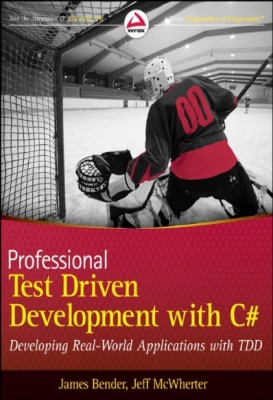A few words about the book "Professional TDD with C #"

I would like to say a few words about the book Professional Test Driven Development with C #. Selecting a book on popular programming techniques and technologies is not that difficult. It is written on every forum that if you want to learn .NET, you cannot do without Richter. More difficult with less popular topics. So TDD ...
')
Short
This is my first Wrox book. The publication has passed the test. In my opinion, a very worthy book. The first thing that pleases - it is short. 300 pages. The book is very compact written. No water and no chewed examples. Everything is laid out on the shelves. In this volume it is easy to navigate and you can at any time find the information you are looking for.
Walk right on the table of contents. Better than a book about the book, no one will tell.
Part 1.
Chapter 1 describes how software was developed, how the development style evolved, and how developers arrived at TDD.
Chapter 2 - introductory chapter in testing. Here it is told what a test is. What does it consist of. What is the difference dummy / fake / stub / mock.
Chapter 3 is about refactoring. Principles of OOP. SOLID. Techniques and examples of refactoring.
Chapter 4 talks about TDD itself. What if a test is written before the code, then this is TDD. If on the contrary, the author is not responsible for the deadlines for the delivery of your project.
Chapter 5 contains information about Dependency Injection and Mock. Why and how are used. Examples of implementation.
Part 2.
Chapter 6. From the beginning to the end, the process of creating an application is analyzed. Creating a project structure in VisualStudio. Rules and tips for writing User Stories. Introduction to Agile.
Chapter 7. Getting started to implement the application. Line by line, test by test.
Chapter 8. Integration Testing. Integration (like in Russian) tests are described. The creation example is again present.
Part 3
Chapter 9 describes web application testing techniques. Briefly described how to test ASP.Net Web Forms projects. Further, a rather detailed analysis of testing ASP.Net MVC projects. And finally, a couple of words about JavaScript Testing Frameworks.
Chapter 10 describes techniques for testing WCF services.
Chapter 11 talks about testing WPF and SilverLight applications. It is explained how the MVVM pattern will facilitate this task for us.
Part 4
Chapter 12 contains general words about strategies for working with new requirements and defects within TDD.
Chapter 13 emphasizes the author's impartiality to different frameworks. Here are briefly described the advantages and disadvantages of many Unit Testing Frameworks, Test Runners, Mocking Frameworks, DI Frameworks and several useful tools.
Chapter 14 summarizes what has been read. Here the author gives the last instructions, and even advice, on how to implement TDD in their companies more painlessly.
Conclusion
Good book. Very nice and well written. Code samples can be downloaded from the site. It is worth noting that in translation it is not, and will have to read in English. The complexity of writing, from the point of view of the language, is slightly higher than the same Richter, but not by much. The book has collected a huge amount of information, ranging from refactoring to Agile development and BDD notation. Each such item is described in 20-30 pages, which is enough to understand the main idea and buy already specialized books on taste.
I also liked the cover. A hockey player is drawn on it. Here it is.
I hope this information is enough to form an opinion about the book. On the publisher's website, you can download the first chapter in PDF.
Book Information:
Professional Test Driven Development with C #
Developing Real-World Apllications with TDD
Authors: James Bender, Jeff McWherter
Wrox Publisher
ISBN 978-0-470-64320-4
Source: https://habr.com/ru/post/176637/
All Articles